On the Use of the Disability-Adjusted Life Year (DALY) Estimator as a Metric to Optimally Manage ICE Emissions
Abstract
:1. Introduction
2. Materials and Methods
2.1. Assessment of Human Health Damage Due to Engine Emissions
2.2. Engine Management at Minimum Damage Conditions
2.3. Application of the Minimum Damage Management Criterion to a Passenger Vehicle
- -
- Diesel engine with automatic transmission managed according to the minimum consumption strategy (hereinafter referred to as AUT-C), the minimum damage strategy (AUT-D), and, for a fair comparison, the manual gear shift strategy (AUT-M);
- -
- Diesel engine with continuous transmission managed according to the minimum consumption strategy (hereinafter referred to as CVT-C) and the minimum damage strategy (CVT_D);
- -
- Reference powertrain: diesel engine with traditional 6-speed transmission (hereinafter referred to as 6SG).
2.3.1. Vehicle Model
2.3.2. Transmission Modeling and Simulations
3. Results and Discussion
4. Conclusions
- The minimum damage strategy can be easily implemented, as it does not require additional hardware, just a different calibration of the engine control system.
- The minimum damage strategy involved significant reductions compared with the minimum fuel consumption strategy. These reductions were greater in CVT than in Automatic. In fact, the powertrain with CVT showed a 55% reduction in health damage, whereas the powertrain with automatic transmission only 20%. However, the reductions are associated with 9 and 4% increases in fuel consumption, respectively. Therefore, a compromise criterion between the two proposed strategies could be more advantageous for the powertrain with CVT.
- By comparing the behaviors of the two strategies with the reference one, a rather surprising fact can be observed. While allowing for significant reductions in fuel consumption, the minimum fuel consumption strategy cannot guarantee damage reductions. On the contrary, it caused damage increases reaching up to 50%. On the other hand, the minimum damage strategy reduced both fuel consumption and damage for both powertrains considered.
Author Contributions
Funding
Institutional Review Board Statement
Informed Consent Statement
Data Availability Statement
Conflicts of Interest
References
- IARC. Monographs on the Evaluation of the Carcinogenic Risks to Humans. 2022. Available online: https://monographs.iarc.who.int/agents-classified-by-the-iarc/ (accessed on 2 May 2022).
- Zhang, F.; Wang, L.; Coskun, S.; Pang, H.; Cui, Y.; Xi, J. Energy Management Strategies for Hybrid Electric Vehicles: Review, Classification, Comparison, and Outlook. Energies 2020, 13, 3352. [Google Scholar] [CrossRef]
- Huang, Y.; Wang, H.; Khajepour, A.; Lib, B.; Jic, J.; Zhao, K.; Hue, C. A review of power management strategies and component sizing methods for hybrid vehicles. Renew. Sustain. Energy Rev. 2018, 96, 132–144. [Google Scholar] [CrossRef]
- Shabbir, W.; Evangelou, S.A. Real-time control strategy to maximize hybrid electric vehicle powertrain efficiency. Appl. Energy 2014, 135, 512–522. [Google Scholar] [CrossRef]
- Hofman, T.; Steinbuch, M.; van Druten, R.M.; Serrarens, A.F.A. Rule-based energy management strategies for hybrid vehicle drivetrains: A fundamental approach in reducing computation time. IFAC Proc. Vol. 2006, 39, 740–745. [Google Scholar] [CrossRef] [Green Version]
- Bonsen, B.; Steinbuch, M.; Veenhuizen, P.A. CVT ratio control strategy optimization. In Proceedings of the 2005 IEEE Vehicle Power and Propulsion Conference, Chicago, IL, USA, 7 September 2005; ISBN 0-7803-9280-9. [Google Scholar] [CrossRef]
- Pfiffner, R.; Guzzella, L.; Onder, C.H. Fuel-optimal control of CVT powertrains. Control Eng. Pract. 2003, 11, 329–336. [Google Scholar] [CrossRef]
- Jiang, Q.; Ossart, F.; Marchand, C. Comparative Study of Real-Time HEV Energy Management Strategies. IEEE Trans. Veh. Technol. 2017, 66, 10875. [Google Scholar] [CrossRef] [Green Version]
- Srivastava, N.; Haque, I. A review on belt and chain continuously variable transmissions (CVT): Dynamics and control. Mech. Mach. Theory 2009, 44, 19–41. [Google Scholar] [CrossRef]
- Macor, A.; Rossetti, A. Fuel consumption reduction in urban buses by using Power Split transmissions. Energy Convers. Manag. 2013, 71, 159–171. [Google Scholar] [CrossRef]
- Macor, A.; Rossetti, A. Control strategies for a powertrain with hydromechanical transmission. Energy Procedia 2018, 148, 978–985. [Google Scholar] [CrossRef]
- Montazeri-Gh, M.; Mahmoodi-k, M. Development a new power management strategy for Power Split hybrid electric vehicles. Transp. Res. Part D 2015, 37, 79–96. [Google Scholar] [CrossRef]
- Hafner, M.; Isermann, R. Multiobjective optimization of feedforward control maps in engine management systems towards low consumption and low emissions. Trans. Inst. Meas. Control. 2003, 25, 57–74. [Google Scholar] [CrossRef]
- Tang, L.; Rizzoni, G. Energy Management Strategy Including Battery Life Optimization for a HEV with a CVT. In Proceedings of the 2016 IEEE Transportation Electrification Conference and Expo, Asia—Pacific (ITEC), Busan, Korea, 1–4 June 2016. [Google Scholar]
- Johri, R.; Filipi, Z. Optimal energy management of a series hybrid vehicle with combined fuel economy and low-emission objectives. Proc. IMechE Part D J. Automob. Eng. 2014, 228, 1424–1439. [Google Scholar] [CrossRef]
- Masih-Tehrani, M.; Ebrahimi-Nejad, S.; Dahmardeh, M. Combined fuel consumption and emission optimization model for heavy construction equipment. Autom. Constr. 2020, 110, 103007. [Google Scholar] [CrossRef]
- Kazemi, R.; Raf’at, M.; Reza Noruzi, A. Nonlinear Optimal Control of Continuously Variable Transmission Powertrain. Hindawi Publishing Corporation. ISRN Automot. Eng. 2014, 2014, 479590. [Google Scholar]
- Maddumage, W.; Perera, M.; Attalage, R.; Kelly, P. Power Management Strategy of a Parallel Hybrid Three-Wheeler for Fuel and Emission Reduction. Energies 2021, 14, 1833. [Google Scholar] [CrossRef]
- Anwar, H.; Vishwanath, A.; Chunodkar, A. Qadeer Ahmed Comprehensive Energy Footprint Benchmarking of Strong Parallel Electrified Powertrain. arXiv 2021, arXiv:2106.00243. [Google Scholar]
- Hu, X.; Zhang, X.; Tang, X.; Lin, X. Model predictive control of hybrid electric vehicles for fuel economy, emission reductions, and inter-vehicle safety in car-following scenarios. Energy 2020, 196, 117101. [Google Scholar] [CrossRef]
- Tang, X.; Chen, J.; Liu, T.; Qin, Y.; Cao, D. Distributed Deep Reinforcement Learning-Based Energy and Emission management Strategy for Hybrid Electric vehicles. IEEE Trans. Veh. Technol. 2021, 70, 9922–9934. [Google Scholar] [CrossRef]
- Thibault, L.; Sciarretta, A.; Degeilh, P. Reduction of pollutant emissions of diesel mild hybrid vehicles with an innovative energy management strategy. In Proceedings of the 2017 IEEE Intelligent Vehicles Symposium (IV), Redondo Beach, CA, USA, 11–14 June 2017. [Google Scholar]
- Zentner, S.; Asprion, J.; Onder, C.; Guzzella, L. An equivalent emission minimization strategy for causal optimal control of diesel engines. Energies 2014, 7, 1230–1250. [Google Scholar] [CrossRef] [Green Version]
- Nüesch, T.; Cerofolini, A.; Mancini, G.; Cavina, N.; Onder, C.; Guzzella, L. Equivalent Consumption Minimization Strategy for the Control of Real Driving NOx Emissions of a Diesel Hybrid Electric Vehicle. Energies 2014, 7, 3148–3178. [Google Scholar] [CrossRef] [Green Version]
- Babcock, L.R., Jr. A combined pollution index for measurement of total air pollution. J. Air Pollut. Control. Assoc. 1970, 20, 653–659. [Google Scholar] [CrossRef] [PubMed] [Green Version]
- Jolliet, O.; Margni, M.; Charles, R.; Humbert, S.; Payet, J.; Rebitzer, G.; Rosenbaum, R. IMPACT 2002+: A New Life Cycle Impact Assessment Methodology. Int. J. Life Cycle Assess. 2003, 8, 324. [Google Scholar] [CrossRef] [Green Version]
- Macor, A.; Benato, A. Regulated Emissions of Biogas Engines—On Site Experimental Measurements and Damage Assessment on Human Health. Energies 2020, 13, 1044. [Google Scholar] [CrossRef] [Green Version]
- Frischknecht, R.; Jungbluth, N.; Althaus, H.-J.; Bauer, C.; Doka, G.; Dones, R.; Hischier, R.; Hellweg, S.; Humbert, S.; Köllner, T.; et al. Implementation of Life Cycle Impact Assessment Methods; Ecoinvent Report No. 3, v2.0; Swiss Centre for Life Cycle Inventories: Dübendorf, Switzerland, 2007. [Google Scholar]
- SimaPro 7—PRé Consultants, The Netherlands. 2009. Available online: https://simapro.com/wp-content/uploads/2020/10/DatabaseManualMethods.pdf (accessed on 11 April 2022).
- Available online: https://www.seat.com/content/dam/public/seat-website/myco/2028/car-shopping-tools/brochure-download/brochures/ateca/other-shoppingtools-brochure-ateca-specs-final-october-2019.pdf (accessed on 7 December 2021).
- Grote, K.H.; Antonsson, E.K. Springer Handbook of Mechanical Engineering; Springer: Berlin/Heidelberg, Germany, 2009. [Google Scholar] [CrossRef]
- Available online: https://dieselnet.com/standards/cycles/index.php (accessed on 6 December 2021).


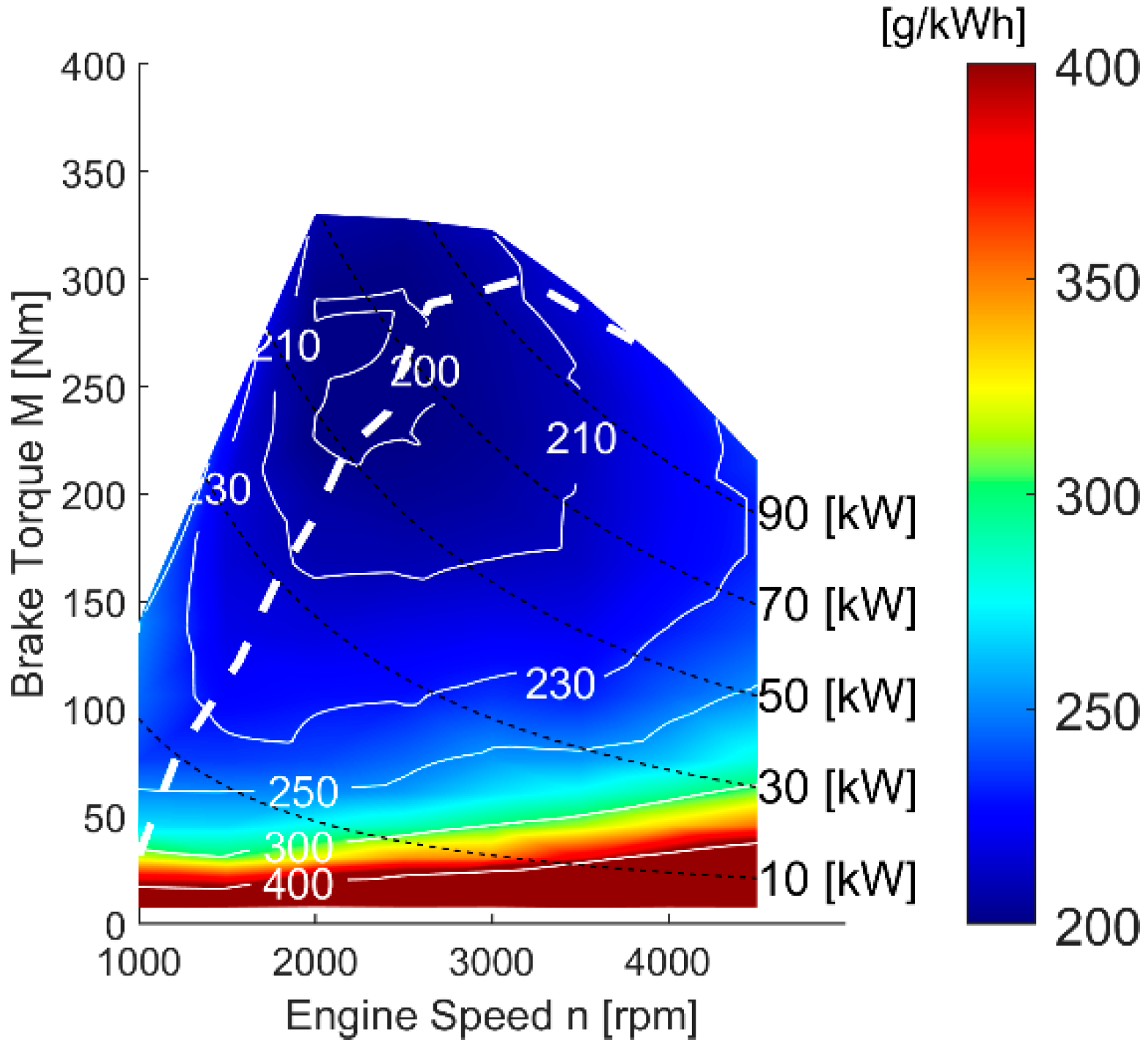
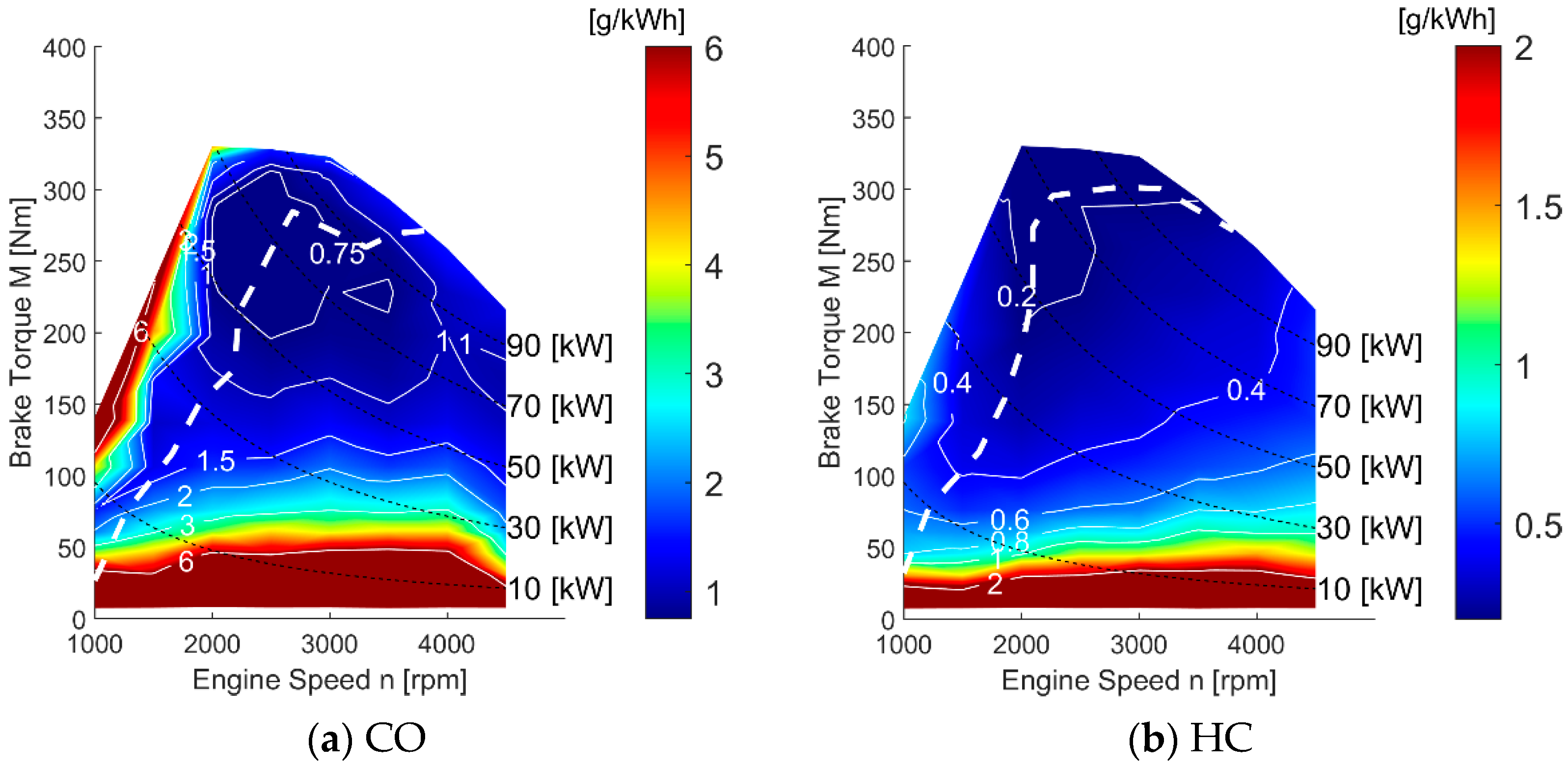

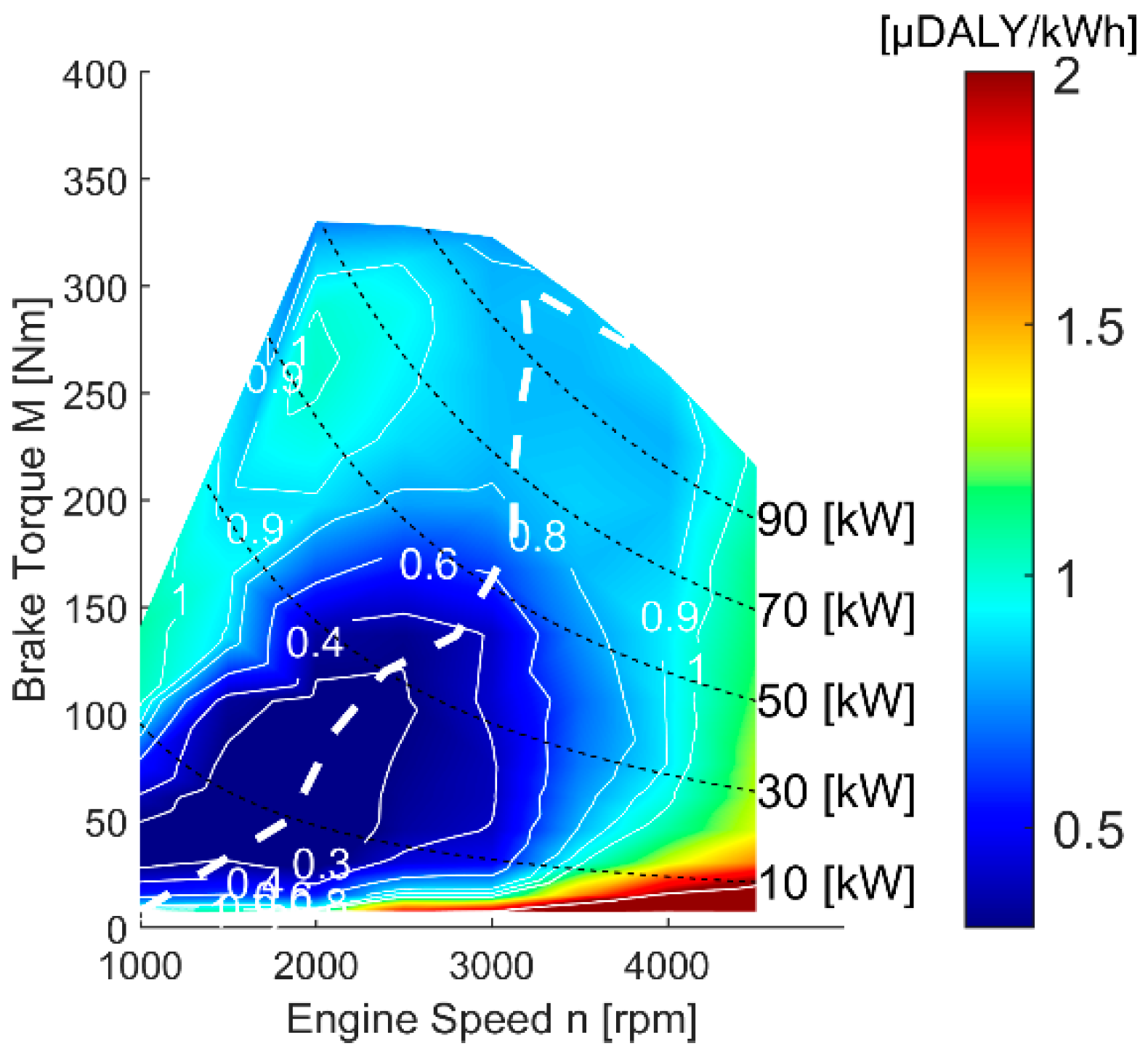

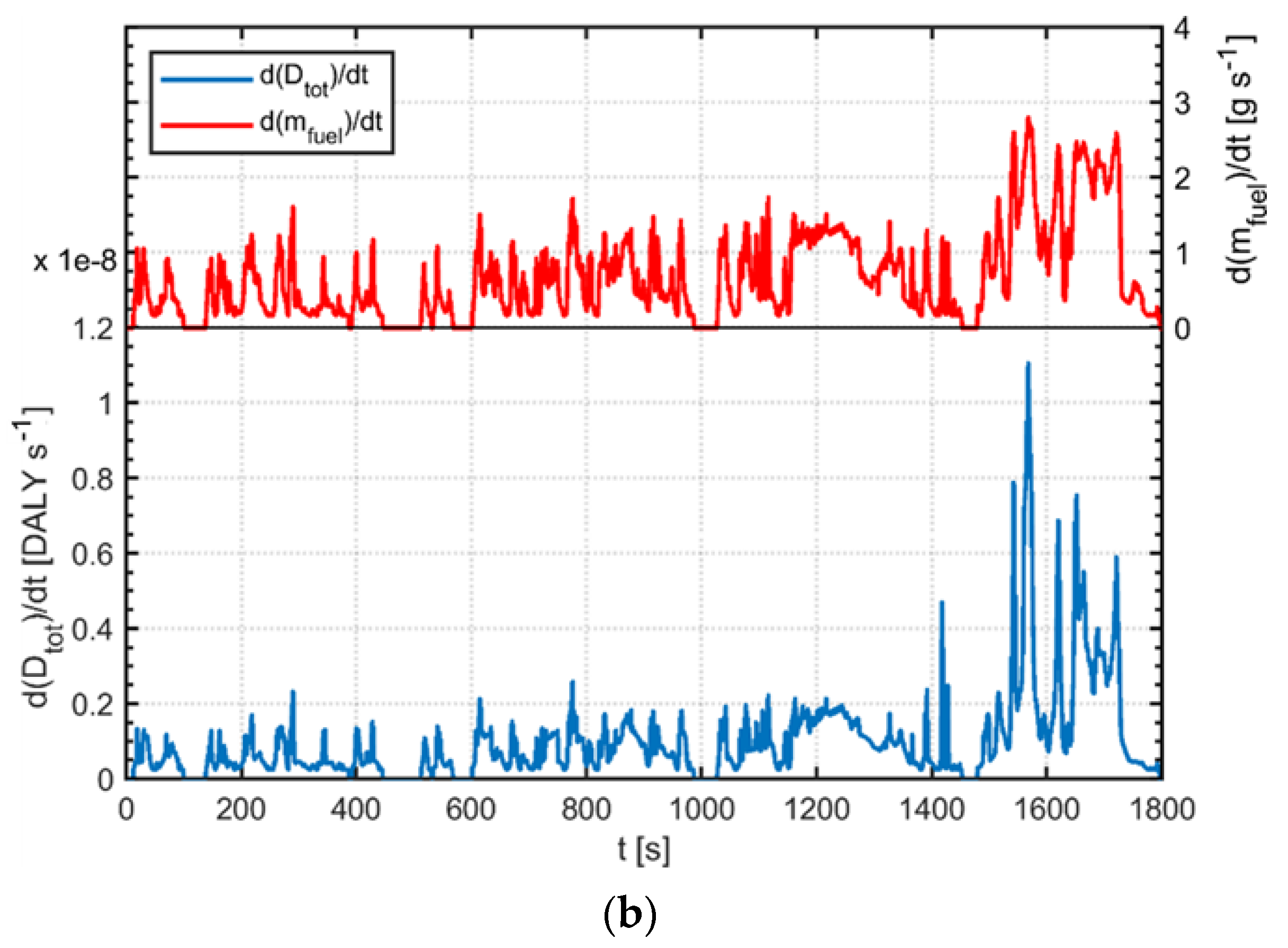
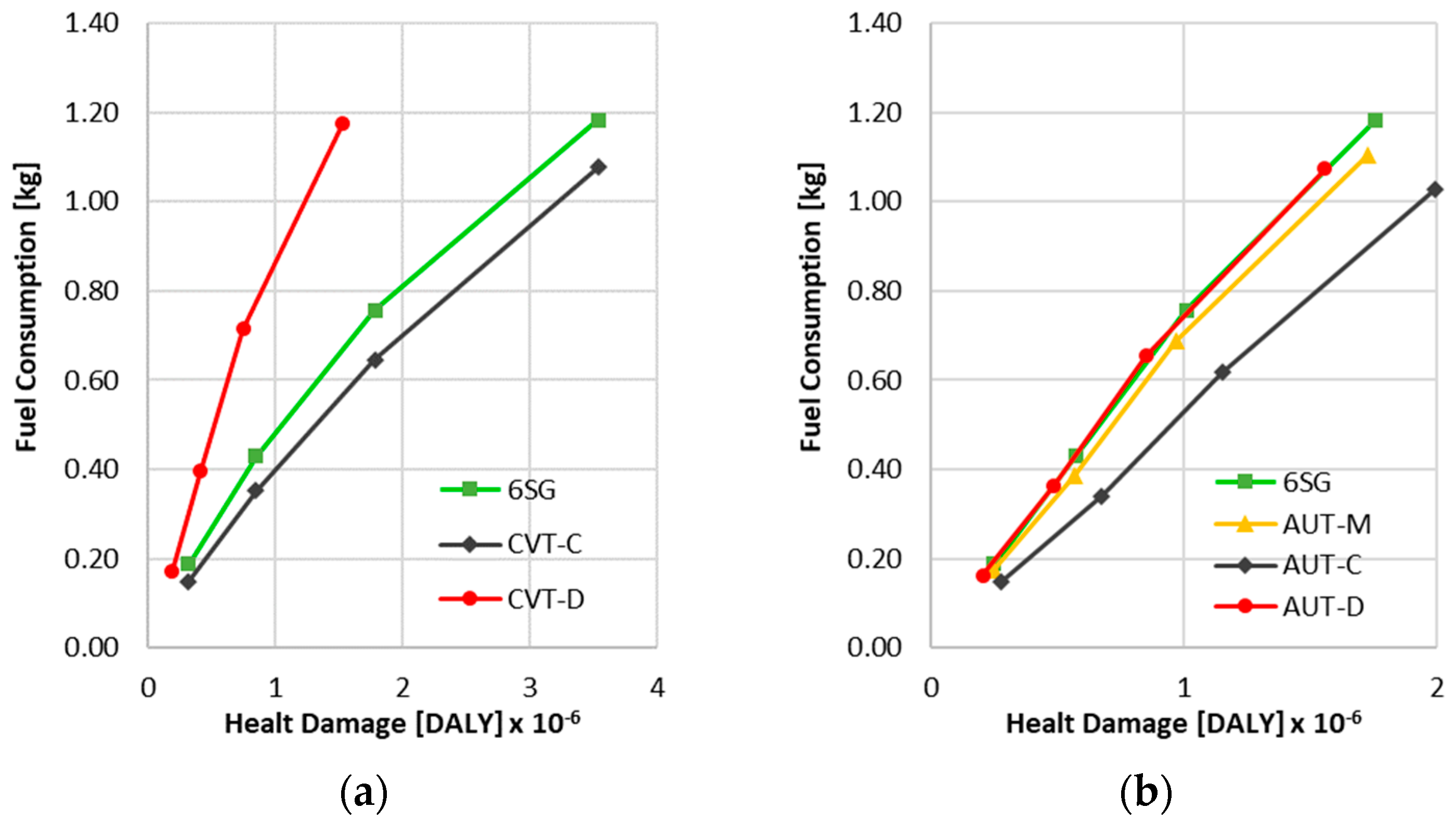
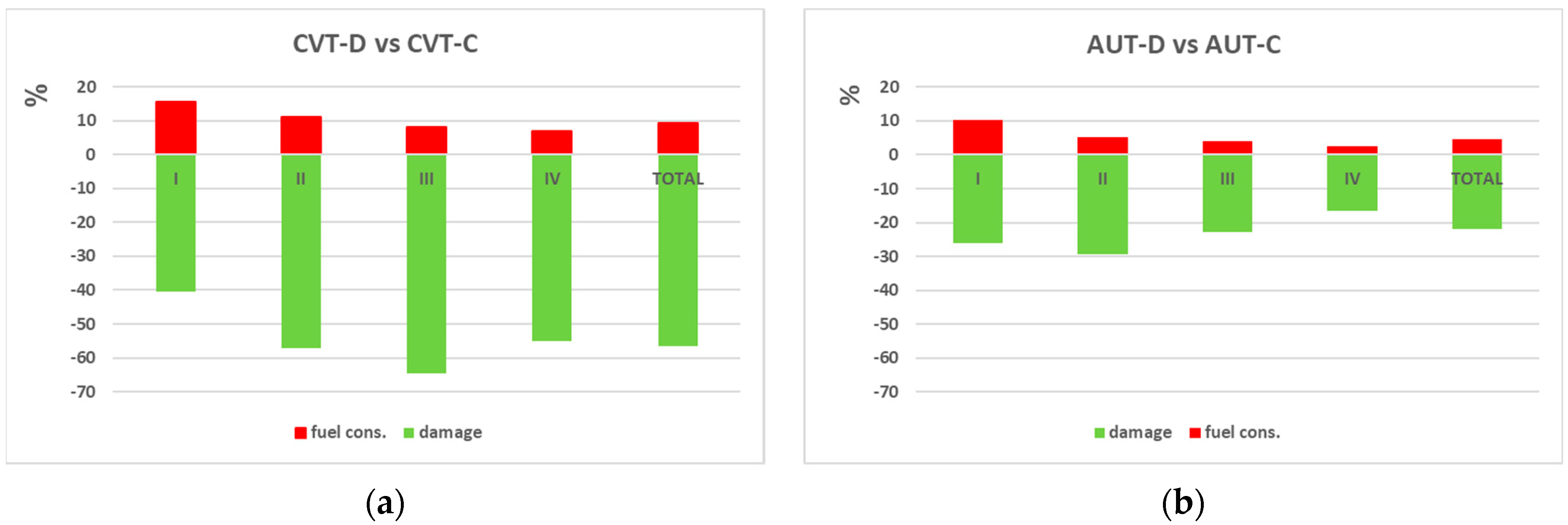

| Emission | cf | unit | sd | unit |
|---|---|---|---|---|
| CO | 1.04 × 10−3 | kg PM2.5 eq/kg | 7.00 × 10−4 | DALY/kg PM2.5 eq |
| NOx | 1.27 × 10−1 | kg PM2.5 eq/kg | 7.00 × 10−4 | DALY/kg PM2.5 eq |
| PM2.5 | 1 | kg PM2.5 eq/kg | 7.00 × 10−4 | DALY/kg PM2.5 eq |
| VOCs | 6.07 × 10−1 | kg C2H4 eq/kg | 2.13 × 10−6 | DALY/kg C2H4 eq |
| Vehicle mass = 2500 kg. |
| Wheel radius = 0.35 m |
| Transmission ratio of the differential gear = 4 |
| Frontal area of the vehicle = 3 m2 |
| Air density = 1.2 kg/m3 |
| Wheel road friction coefficient = 0.01 |
| Drag coefficient = 0.6 |
| Phase | Duration | Stop Duration | Distance | p_stop | v_max | v_ave w/o stops | v_ave w/stops | a_min | a_max |
|---|---|---|---|---|---|---|---|---|---|
| s | s | m | km/h | km/h | km/h | m/s2 | m/s2 | ||
| Low 3 | 589 | 156 | 3095 | 26.5% | 56.5 | 25.7 | 18.9 | −1.47 | 1.47 |
| Medium 3-2 | 433 | 48 | 4756 | 11.1% | 76.6 | 44.5 | 39.5 | −1.49 | 1.57 |
| High 3-2 | 455 | 31 | 7162 | 6.8% | 97.4 | 60.8 | 56.7 | −1.49 | 1.58 |
| Extra-High 3 | 323 | 7 | 8254 | 2.2% | 131.3 | 94.0 | 92.0 | −1.21 | 1.03 |
| Total | 1800 | 242 | 23,266 |
Publisher’s Note: MDPI stays neutral with regard to jurisdictional claims in published maps and institutional affiliations. |
© 2022 by the authors. Licensee MDPI, Basel, Switzerland. This article is an open access article distributed under the terms and conditions of the Creative Commons Attribution (CC BY) license (https://creativecommons.org/licenses/by/4.0/).
Share and Cite
Rossetti, A.; Andretta, N.; Macor, A. On the Use of the Disability-Adjusted Life Year (DALY) Estimator as a Metric to Optimally Manage ICE Emissions. Energies 2022, 15, 4386. https://doi.org/10.3390/en15124386
Rossetti A, Andretta N, Macor A. On the Use of the Disability-Adjusted Life Year (DALY) Estimator as a Metric to Optimally Manage ICE Emissions. Energies. 2022; 15(12):4386. https://doi.org/10.3390/en15124386
Chicago/Turabian StyleRossetti, Antonio, Nicola Andretta, and Alarico Macor. 2022. "On the Use of the Disability-Adjusted Life Year (DALY) Estimator as a Metric to Optimally Manage ICE Emissions" Energies 15, no. 12: 4386. https://doi.org/10.3390/en15124386
APA StyleRossetti, A., Andretta, N., & Macor, A. (2022). On the Use of the Disability-Adjusted Life Year (DALY) Estimator as a Metric to Optimally Manage ICE Emissions. Energies, 15(12), 4386. https://doi.org/10.3390/en15124386









